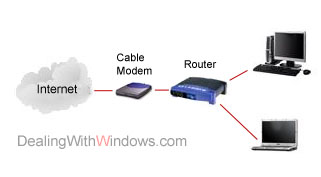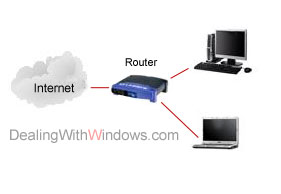 What is a Router?
What is a Router?
- A Router is a network device that forwards data packets to their destinations.
- It’s work represented by it’s name as it does routing to all data packages it receives.
Do I need a Router?
- If you have a LAN network and want to connect it to the Internet then you need a router.
- If you want to use VoIP technology using your LAN network, then definitely you require a router.
What types of Internet connectivity require a Router?
There are two types of broadband Internet connectivity that you need to use a router to provide your home network with the Internet which are:
Cable Internet: Is a very fast internet access that uses the FTTH technology which is using the same TV cable to provide the Internet, the internet speed for residential service reaches 100Mbit/s in some countries.
DSL Internet: A general term which includes the ADSL (Asynchronous Digital Subscriber Line) , is a Internet service technology delivered over copper cables (normal telephone lines cables),sometimes they call it as Dial-Up internet connection, its speed ranges from 128 Kbps up to 3 Mbps.
How does a Router connect?
For Cable Internet service:
If you are using a Cable Internet service from your ISP (Internet Service Provider), so your ISP is providing you a Cable Internet Modem that connecting their Internet network to your home, the router that you have will be connected to that Cable modem via a fast Ethernet cable (using the WAN jack on your router).

From the other side, the same router will be connected to all your network elements using fast Ethernet cables as well.

For ADSL Internet service:
If you are using the ADSL service, you simply connect your Router to your telephone jack to receive the Internet from your ISP, from the other side, the same router will be connected to all your network elements using fast Ethernet cables.

Note: Most modern Routers have Antenna for wireless networking, so to read more about wireless networking and its structure you may refer to the below two lessons:
So Routers can be used at the same time for wired and wireless networking.
[infoclose color=”grey”]How to install and use the Router?
With every Router a Installation CD comes with it, so what you need to do is:
- Connect the router to your computer first using the USB cable that comes with it.
- Then run the installation CD (as shown in the tutorial video of the previous article Wireless Network Installation)
- The installation will complete the router configuration automatically.
What is DHCP?
The DHCP (Dynamic Host Configuration Protocol) is a network protocol that enables a server to automatically assign an IP address to a network elements (like computers) from a defined range of numbers.
So, a server (in our case is the Router) has this protocol so it can assign a dedicated IP address to all the network element that it is connected to it, otherwise a network connection between the router and the network elements will not be established.
[scheaven_infobox color=”grey” width=”100″ align=”none” icon=”info2″]Note: If you are using the Cable Internet you should know that the Router preconfigured with DHCP in its settings, so after installing it you can use it imediatelly, but if you are using the ADSL internet then you need to open the Router configuration panel and change this option from DHCP into PPP0E (Point to Point Protocol Over Ethernet), to do so follow the below steps:
- Open your Internet Browser and type in the address bar the Router IP address that comes with it (check your Router manual) usually 192.168.0.1 for D-Link, and 192.168.1.1 for Netgear or Linksys (check them in your manual to be sure).
- Enter your user name and password (usually the user name is ‘admin’ and the password is ‘admin’ or blank, better to check it in you manual)
- Then from the configuration (which its design and location is differ between routers brands) select the PPP0E and click on save.
For more information follow the steps located in your Router user manual.
[infoclose color=”grey”] [scheaven_infobox color=”green” width=”100″ align=”none” icon=”0″]If you like this article you may RATE IT above, SHARE IT below and POST A COMMENT from below.[infoclose color=”green”]Recent Posts
If your computer is slow to start, it may be damaged by malware or have too many startup programs. or you may have a hardware or software problem. Some Windows have very impressive startup times,...
Online banking is quick and easy. This is why it is so well-liked by people all around the world. Online payments can also cause trouble. You should take security measures for online banking. Hackers...
